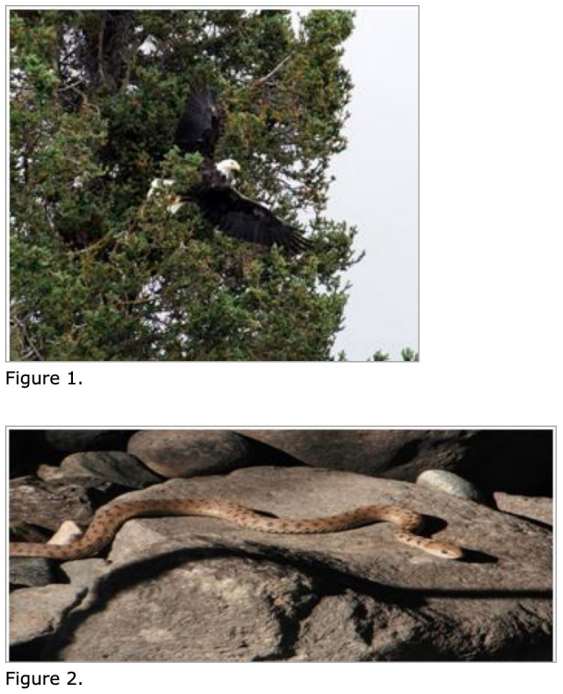The Big Creek confluence is home to diverse wildlife! The slower moving Big Creek allows mammals to easily cross from a mixed forest habitat to the open fields on the downstream side. The creek with its clear water also provides excellent year-round foraging opportunities for a variety of wildlife, both mammals and bird. The Chilcotin river bank is well utilized during the salmon runs. The spawning fish tend to travel in the slower current along the edges which makes them an easier target for terrestrial predators.
One of the most easily spotted birds is the majestic Bald Eagle (Figure 1), which can be seen flying up the creek canyon, only to return through the Chilcotin canyon looking for fish. The eagles come to rest in one of the taller conifers usually, which affords a good view of both Big Creek and the Chilcotin River. The edge of the Chilcotin is a commonly used feeding are as evident by their whitish scat covering most of the boulders. There are other, smaller raptors present as well, such as Sharp-shinned Hawk, Red-tailed Hawk and Peregrine Falcon.
The riparian vegetation is home to many small birds, such as the flycatcher using the brush for nesting and cover from predators. Walking along the creek their songs can easily be heard. On the downstream side of the creek flocks of sparrows like the Savannah sparrow among others, use the open spaces to forage.
Along the creek and the river one can also find both garter and gopher snakes. The variety of garter snake we found during our stay was a stripe-less color morph (Figure 2). Both the garter and gopher snakes were found among the rocks at the water's edge.
In the campground area we saw yellow pine chipmunk and also red squirrel. The chipmunks forage on top of logs where the remains of the red kinnikinick berries can be seen. The squirrels feed on nuts and pine cones, seemingly favoring the Douglas firs, based on the piles of scales at the base of the trunks. Scat from snowshoe hare and a skull from a wood rat were also found in the more interior area.
On a hike around the confluence you can find evidence of, or encounter, a number of larger mammals as well. Well used wildlife trails run along the edge and through the interior of the upstream area, and there are also several on the downstream side of Big Creek, through the more open fields.
As our group pulled in, a very large, golden colored coyote was seen. More shy than the urban individuals, it was not seen again during our stay however. We also found tracks and scat left by black bear up on the ridge along Big Creek. Bear scat is easily recognized by the size and the content consisting of an omnivore mix; mostly berries and seeds, but also insect parts, fur and at times small bones. Further upstream along Big Creek bones from salmonids could be seen far from water's edge, up on the terrace, taken there for an undisturbed meal. Bear will fish and coyotes will at least scavenge on dead or injured fish.
Several large herbivores are also present; tracks and scat were found from moose, elk and deer. A few deer were also seen, one on the island in Chilcotin, just above the Big Creek confluence.
As the sun sets the bats (Myotis genus) come out to find insects over Big Creek and can be watched from the ledge of the terrace at the camp site. After a day of exploring there is nothing more to do than to admire their precision flying and be thankful they eat the mosquitoes!

